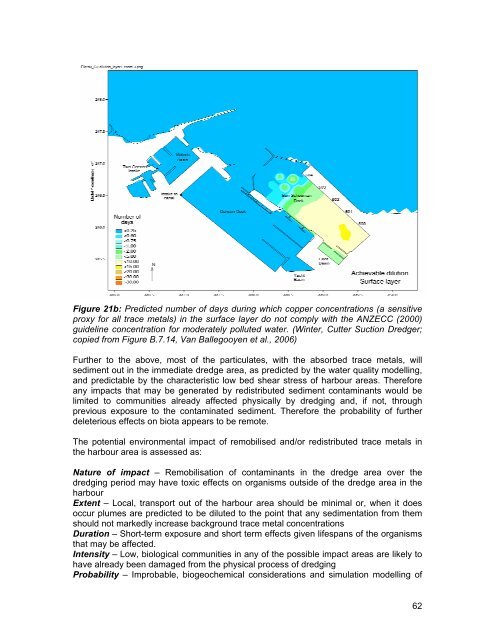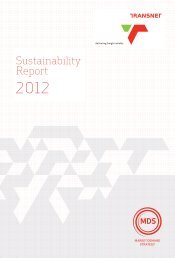BEN SCHOEMAN DOCK BERTH DEEPENING Specialist ... - Transnet
BEN SCHOEMAN DOCK BERTH DEEPENING Specialist ... - Transnet
BEN SCHOEMAN DOCK BERTH DEEPENING Specialist ... - Transnet
Create successful ePaper yourself
Turn your PDF publications into a flip-book with our unique Google optimized e-Paper software.
Figure 21b: Predicted number of days during which copper concentrations (a sensitive<br />
proxy for all trace metals) in the surface layer do not comply with the ANZECC (2000)<br />
guideline concentration for moderately polluted water. (Winter, Cutter Suction Dredger;<br />
copied from Figure B.7.14, Van Ballegooyen et al., 2006)<br />
Further to the above, most of the particulates, with the absorbed trace metals, will<br />
sediment out in the immediate dredge area, as predicted by the water quality modelling,<br />
and predictable by the characteristic low bed shear stress of harbour areas. Therefore<br />
any impacts that may be generated by redistributed sediment contaminants would be<br />
limited to communities already affected physically by dredging and, if not, through<br />
previous exposure to the contaminated sediment. Therefore the probability of further<br />
deleterious effects on biota appears to be remote.<br />
The potential environmental impact of remobilised and/or redistributed trace metals in<br />
the harbour area is assessed as:<br />
Nature of impact – Remobilisation of contaminants in the dredge area over the<br />
dredging period may have toxic effects on organisms outside of the dredge area in the<br />
harbour<br />
Extent – Local, transport out of the harbour area should be minimal or, when it does<br />
occur plumes are predicted to be diluted to the point that any sedimentation from them<br />
should not markedly increase background trace metal concentrations<br />
Duration – Short-term exposure and short term effects given lifespans of the organisms<br />
that may be affected.<br />
Intensity – Low, biological communities in any of the possible impact areas are likely to<br />
have already been damaged from the physical process of dredging<br />
Probability – Improbable, biogeochemical considerations and simulation modelling of<br />
62

















